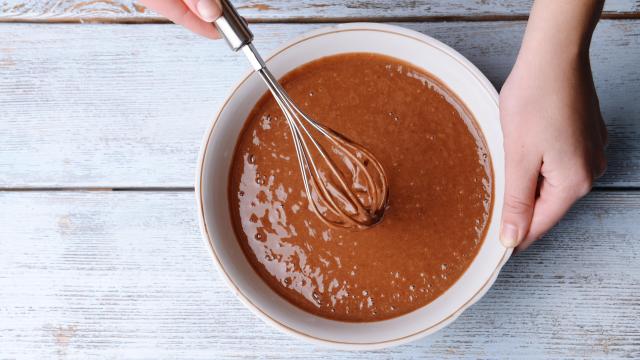This trick, like many kitchen origin stories, came from necessity. A friend and I were preparing a Funfetti cake for a birthday party, and realised we only had two eggs instead of the requisite three. With no time to run out to the store, and the gall a glass of wine’ll give you, we figured, what’s the worst that could happen? We left out the egg, and — with the addition of my friend’s heavy-handed oil measuring — we baked a bundt cake. And the most tender, finely crumbed Funfetti cake the world has ever known came out of the pan that day.
Boxed cake gets a lot of shade for tasting artificial, but if you enjoy the flavour for what it is — a striking mélange of overwhelming saccharine flavours topped off with a splash of imitation vanilla — then you can turn your attention to what really needs improvement: the rubbery texture. Thankfully, this trick is incredibly simple, and doesn’t require any suspicious applesauce hocus pocus. The instructions on the back of the box usually include added ingredients like eggs, water, and oil. (I’m speaking to those of us buying Duncan Hines, Betty Crocker, Pillsbury, and the like; if you’re using some organic, fair trade, gluten-free boxed mix, I can’t promise the same success.) Simply subtract one whole egg, add an additional ¼ cup of oil, and proceed with the mixing method and baking times as instructed on the back of the box.
By leaving out one of the eggs, you’re taking away some of the binding power that the proteins in the egg contribute — if there are too many, the resulting cake can become tough and rubbery. Instead of your fork gliding through it, like a cake made from scratch, the cake fights against your utensil, bouncing back and revealing its tough texture. But by removing one, you take away just enough rubbery protein to give the cake a delicate, tender crumb. The texture is more melt-in-your-mouth versus chewing a brisket. And this is no mistake: Boxed cakes are designed to be easy for an amateur baker — someone likely to over-bake the cake, not properly prepare the pan, lift, layer, and frost while still hot — and still not fall apart. The egg content helps make the cake more durable.
The addition of an extra ¼ cup of oil does two things. It replaces the missing volume in the batter from the omitted egg, and returns richness lost from the omitted yolk, plus a dab extra for good luck. The result is a pleasantly moist cake that just holds together, cuts easily with a fork and doesn’t feel the least bit dry on your tongue. You could even skip frosting all together.
Even though I don’t make boxed cakes very often, I will absolutely do this every single time to get a more homemade texture. The results were too good to ignore. However, I’m experienced with handling delicate cakes. Note that more tender means more difficult to handle. If you plan on stacking cake layers, or covering it with a sticky or stiff frosting, remember to always cool the cake layers thoroughly first. Better yet, once the layers are out of the pan and on a cooling rack, put the cooling rack in the fridge or freezer for an hour. They’ll be extra firm and there’s much less risk of breakage. I’m a huge fan of bundt cakes, if you’re in a pinch for time. They’re lovely, low-fuss, and look quite elegant with a simple dusting of powdered sugar.

Leave a Reply
You must be logged in to post a comment.